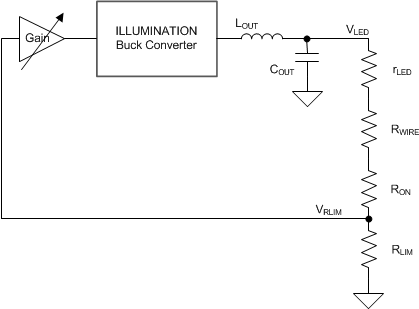ZHCSE87A October 2015 – September 2023 DLPA3000
PRODUCTION DATA
- 1
- 1 特性
- 2 应用
- 3 说明
- 4 Revision History
- 5 说明(续)
- 6 Pin Configuration and Functions
- 7 Specifications
-
8 Detailed Description
- 8.1 Overview
- 8.2 功能方框图
- 8.3
Feature Description
- 8.3.1 Supply and Monitoring
- 8.3.2 Illumination
- 8.3.3 DMD Supplies
- 8.3.4 Buck Converters
- 8.3.5 Auxiliary LDOs
- 8.3.6 Measurement System
- 8.3.7 Digital Control
- 8.4 Device Functional Modes
- 8.5 Register Maps
- 9 Application and Implementation
- 10Power Supply Recommendations
- 11Layout
- 12Device and Documentation Support
- 13Mechanical, Packaging, and Orderable Information
封装选项
机械数据 (封装 | 引脚)
- PFD|100
散热焊盘机械数据 (封装 | 引脚)
- PFD|100
订购信息
8.3.2.1 Programmable Gain Block
The current through the LEDs is determined by a digital number stored in the respective SWx_IDAC(x) registers (0x03 to 0x08). These registers determine the LED current which is measured through the sense resistor RLIM. The voltage across RLIM is compared with the current setting from the SWx_IDAC(x) registers (0x03 to 0x08) and the loop regulates the current to its set value.
 Figure 8-5 Programmable Gain Block in the Illumination Control Loop
Figure 8-5 Programmable Gain Block in the Illumination Control LoopWhen current is flowing through an LED, a forward voltage is built up over the LED. The LED also represents a (low) differential resistance, which is part of the load circuit for VLED. Together with the wire resistance (RWIRE) and the RON resistance of the FET switch, a voltage divider is created with RLIM that is a factor in the loop gain of the ILED control. Under normal conditions, the loop is able to produce a well-regulated LED current of up to 6 A.
Since this voltage divider is part of the control loop, care must be taken while designing the system.
For instance, when two LEDs are connected in series, or when a relatively high wiring resistance is present in the loop, the loop gain will reduce due to the extra attenuation caused by the increased series resistances of rLED + RWIRE +RON. As a result, the loop response time is shortened. The loop gain is set to a default value which achieves good performance and no further adjustments are necessary.
As discussed previously, wiring resistance also impacts the control-loop performance. It is advisable to prevent unnecessary large-wire length in the loop. Keeping wiring resistance as low as possible is good for efficiency reasons. In case wiring resistance still impacts the response time of the loop, an appropriate setting of the gain block can be selected. The same goes for connector resistance and PCB tracks. Note that every milliohm (mΩ) counts. These precautions help to maintain the proper functioning of the ILED current loop.